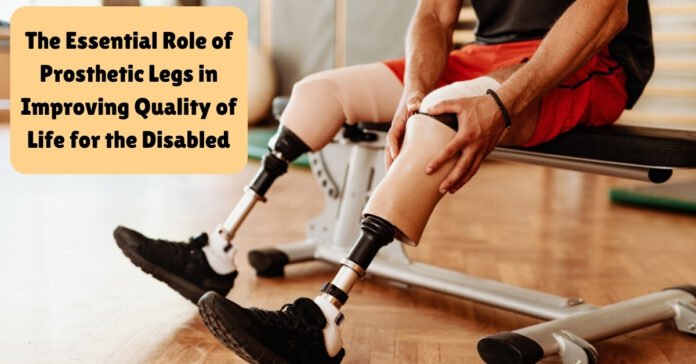
Prosthetic legs have transformed the lives of individuals with limb loss, providing them with new mobility, independence, and significantly enhanced quality of life. These advanced devices are not just replacements for lost limbs; they are engineered solutions that empower users to reclaim their lives, engage in daily activities, and fully participate in society. From facilitating basic movements to supporting athletic endeavors, prosthetic legs play a crucial role in improving the physical, psychological, and social well-being of disabled individuals.
How Do Prosthetic Legs Improve Quality of Life?
Prosthetic legs significantly enhance the quality of life for individuals with limb loss by restoring mobility, independence, and a sense of normalcy. These devices enable users to walk, run, and perform various physical activities essential for maintaining overall health and well-being. By facilitating regular movement, prosthetic legs help prevent secondary health issues such as obesity, cardiovascular diseases, and muscle atrophy.
Being able to move independently boosts self-esteem and confidence, reduces reliance on caregivers, and fosters a sense of achievement. This newfound independence allows individuals to engage more actively in social interactions, community events, and professional opportunities, promoting social inclusion and employability.
Modern prosthetics are designed for both comfort and functionality, ensuring users can participate in a wide range of activities with minimal discomfort. Overall, prosthetic legs empower individuals to lead more active, fulfilling, and independent lives, significantly improving their physical and mental well-being.
Roles of a Prosthetic Leg
1. Restoring Mobility
Prosthetic legs are primarily designed to restore mobility to individuals who have lost a limb. They enable users to walk, run, and perform various physical activities, mimicking the natural movement of a human leg. This restoration of movement is fundamental to enhancing the independence and daily functioning of users, allowing them to navigate different environments confidently and easily.
2. Enhancing Physical Health
Regular physical activity is essential for maintaining overall health and well-being. Prosthetic legs allow users to stay active, preventing secondary health issues such as obesity, cardiovascular diseases, and muscle atrophy. The ability to engage in exercises and other physical activities helps improve cardiovascular health, muscle strength, and endurance, contributing to a healthier lifestyle.
3. Challenging Stereotypes and Reducing Stigma
The visible use of prosthetic legs can help challenge stereotypes and reduce the stigma associated with disabilities. Seeing individuals with prosthetics lead active and fulfilling lives can change societal perceptions and promote a more inclusive and accepting environment. This shift in attitudes encourages greater accessibility and support for disabled individuals in various aspects of life.
4. Reducing Dependence on Caregivers
Prosthetic legs reduce the need for constant assistance from caregivers and family members. This increased autonomy allows individuals to perform daily activities such as getting dressed, cooking, and traveling independently. Reducing dependence on others enhances the user’s quality of life and alleviates the burden on caregivers, fostering a sense of mutual relief and satisfaction.
5. Facilitating Social Interaction
Prosthetic legs play a crucial role in facilitating social interaction and integration. With restored mobility, individuals can attend social gatherings, participate in community events, and engage in recreational activities. This social engagement helps build and maintain relationships, reducing feelings of isolation and promoting a sense of belonging within the community.
6. Improving Employability
For many disabled individuals, prosthetic legs can open up opportunities for education and employment. The ability to move independently makes it easier to attend school, pursue higher education, and seek gainful employment. Many workplaces are now more accommodating of employees with prosthetic limbs, recognizing their capabilities and contributions, which further enhances their employability and career prospects.
7. Supporting Children’s Growth
Children who require prosthetics face unique challenges, as they rapidly outgrow their devices. Prosthetic legs designed for pediatric use can accommodate a child’s growth and changing needs, reducing the frequency and cost of replacements. These devices enable children to participate in play, sports, and educational activities, promoting healthy development and social interaction.
8. Boosting Self-Confidence
The use of prosthetic legs can significantly boost the self-confidence and self-esteem of individuals with limb loss. Being able to move independently and perform daily tasks enhances one’s sense of self-worth and accomplishment. This confidence spills over into other areas of life, encouraging users to pursue personal and professional goals with greater determination and optimism.
9. Customization and Comfort
Modern prosthetic legs can be highly customized to fit the unique anatomy and requirements of each user. Advances in materials and design have led to the development of lightweight and durable prosthetics that offer greater comfort. Custom-fit sockets, adjustable components, and advanced suspension systems ensure that the prosthetic limb stays securely in place, minimizing discomfort and skin irritation.
10 Advancements in Technology
The field of prosthetics is continuously evolving, with new technologies and innovations on the horizon. Advances in robotics, artificial intelligence, and materials science are leading to the development of more sophisticated and functional prosthetic legs. These next-generation prosthetics offer enhanced mobility, improved sensory feedback, and greater customization options, further improving the user experience and quality of life.
Conclusion
Prosthetic legs are transformative tools offering numerous benefits to individuals with limb loss. By restoring mobility, enhancing physical health, and boosting self-confidence, these devices empower users to lead more independent and fulfilling lives. The psychological and social impacts of prosthetic legs further highlight their value, promoting mental well-being, social inclusion, and employability.
As technology continues to advance, the future of prosthetic legs holds immense promise, with innovations set to make these devices even more functional, comfortable, and accessible. Prosthetic leg manufacturers in India and around the world play a crucial role in making high-quality prosthetics available to a broader population, ensuring that more individuals can benefit from these life-changing devices.
By leveraging these advancements, we can continue to improve the quality of life for individuals with limb loss and create a more inclusive and supportive society. The role of prosthetic legs in disabled people’s lives is undeniably transformative—offering not just the ability to walk, but the opportunity to thrive.

